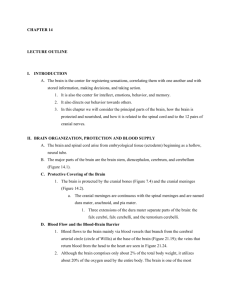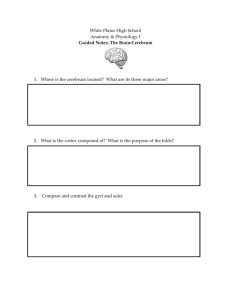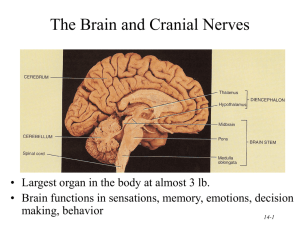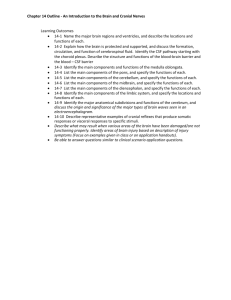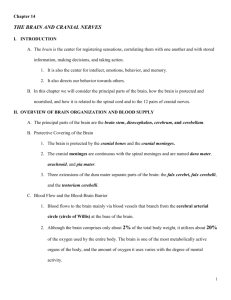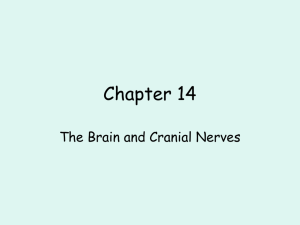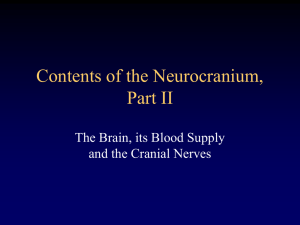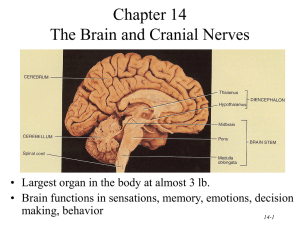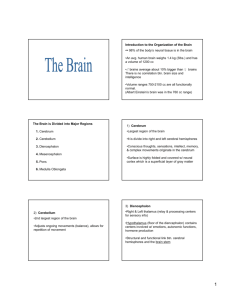Lecture Notes
advertisement
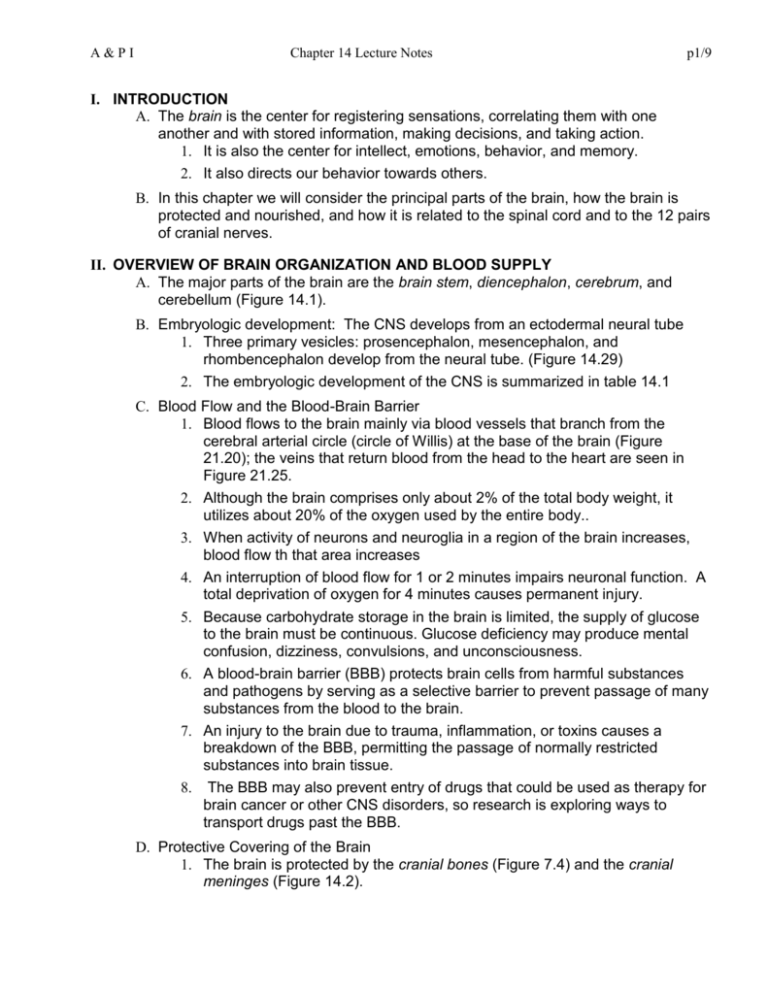
A&PI Chapter 14 Lecture Notes p1/9 I. INTRODUCTION A. The brain is the center for registering sensations, correlating them with one another and with stored information, making decisions, and taking action. 1. It is also the center for intellect, emotions, behavior, and memory. 2. It also directs our behavior towards others. B. In this chapter we will consider the principal parts of the brain, how the brain is protected and nourished, and how it is related to the spinal cord and to the 12 pairs of cranial nerves. II. OVERVIEW OF BRAIN ORGANIZATION AND BLOOD SUPPLY A. The major parts of the brain are the brain stem, diencephalon, cerebrum, and cerebellum (Figure 14.1). B. Embryologic development: The CNS develops from an ectodermal neural tube 1. Three primary vesicles: prosencephalon, mesencephalon, and rhombencephalon develop from the neural tube. (Figure 14.29) 2. The embryologic development of the CNS is summarized in table 14.1 C. Blood Flow and the Blood-Brain Barrier 1. Blood flows to the brain mainly via blood vessels that branch from the cerebral arterial circle (circle of Willis) at the base of the brain (Figure 21.20); the veins that return blood from the head to the heart are seen in Figure 21.25. 2. Although the brain comprises only about 2% of the total body weight, it utilizes about 20% of the oxygen used by the entire body.. 3. When activity of neurons and neuroglia in a region of the brain increases, blood flow th that area increases 4. An interruption of blood flow for 1 or 2 minutes impairs neuronal function. A total deprivation of oxygen for 4 minutes causes permanent injury. 5. Because carbohydrate storage in the brain is limited, the supply of glucose to the brain must be continuous. Glucose deficiency may produce mental confusion, dizziness, convulsions, and unconsciousness. 6. A blood-brain barrier (BBB) protects brain cells from harmful substances and pathogens by serving as a selective barrier to prevent passage of many substances from the blood to the brain. 7. An injury to the brain due to trauma, inflammation, or toxins causes a breakdown of the BBB, permitting the passage of normally restricted substances into brain tissue. 8. The BBB may also prevent entry of drugs that could be used as therapy for brain cancer or other CNS disorders, so research is exploring ways to transport drugs past the BBB. D. Protective Covering of the Brain 1. The brain is protected by the cranial bones (Figure 7.4) and the cranial meninges (Figure 14.2). A&PI Chapter 14 Lecture Notes p2/9 2. The cranial meninges are continuous with the spinal meninges and are named dura mater, arachnoid, and pia mater. 3. Three extensions of the dura mater separate parts of the brain: the falx cerebri, falx cerebelli, and the tentorium cerebelli. 4. Bleeding into the subdural space (subdural hemorrhage) leads to a hematoma. Symptoms include drowsiness, confusion, and coma. This condition is life threatening and requires immediate attention. III. CEREBROSPINAL FLUID A. Cerebrospinal fluid (CSF) is a clear, colorless liquid that protects the brain and spinal cord against chemical and physical injuries and carries oxygen, glucose, and other needed chemicals from the blood to neurons and neuroglia. B. There are four CSF filled cavities within the brain called ventricles (Figure 14.3). 1. A lateral ventricle is located in each hemisphere of the cerebrum. The lateral ventricles are separated by the septum pellucidum. 2. The third ventricle is a narrow cavity along the midline superior to the hypothalamus and between the right and left halves of the thalamus. 3. The fourth ventricle is between the brain stem and the cerebellum. C. CSF contributes to homeostasis by providing mechanical protection, chemical protection, and circulation. D. CSF is formed by filtration from networks of capillaries called choroid plexuses (found in the ventricles) and circulates through the subarachnoid space, ventricles, and central canal. E. Materials entering CSF from the choroid capillaries cannot leak between the surrounding ependymal cells; these constitute the blood-cerebrospinal fluid barrier, which permits certain substances to enter the fluid but excludes others and protects the brain and spinal cord from harmful elements (Figures 14.4, 4.1). F. Most of the fluid is absorbed by the arachnoid villi of the superior sagittal blood sinus (Figure 14.2); this absorption normally occurs at the same rate at which CSF is produced in the choroid plexuses, thereby maintaining a relatively constant CSF volume and pressure (Figure 14.2). G. If CSF cannot circulate or drain properly due to some obstruction in the ventricles or subarachnoid space, a condition called hydrocephalus develops. The fluid buildup that occurs causes increased pressure on the brain, either internally or externally, depending on where the blockage is present. Surgically draining the ventricles and diverting the flow of CSF by an implanted shunt can positively and dramatically affect the individual’s prognosis. IV. THE BRAIN STEM A. Medulla Oblongata 1. The medulla oblongata, or just medulla, is continuous with the upper part of the spinal cord and contains portions of both motor and sensory tracts (Figures 14.5, 14.1). A&PI Chapter 14 Lecture Notes p3/9 2. It also contains the nuclei of origin for cranial nerves VIII (cochlear and vestibular branches) through XII (Table 14.2). 3. Structural regions of the medulla include the pyramids (Figures 14.5, 14.6) and the inferior olivary nucleus (Figures 14.5, 14.6). a. Decussation of pyramids results in neurons in the left cerebral cortex controlling skeletal muscles on the right side of the body and neurons in the right cerebral cortex controlling skeletal muscles on the left side. b. Inferior olivary neurons relay impulses from proprioceptors to the cerebellum. 4. Functional regions include nuclei that are reflex centers for regulation of heart rate, respiratory rate, vasoconstriction, swallowing, coughing, vomiting, sneezing, and hiccuping; the first three are considered vital reflexes. 5. The medulla contains nuclei associated with five pairs of carnial nerves: VIII vestibulochoclear, IX glossopharyngeal, X vagus, XI accessory, and XII hypoglossal. 4. Injury to the medulla can be fatal or lead to serious problems. B. Pons 1. The pons is located superior to the medulla. It connects the spinal cord with the brain and links parts of the brain with one another by way of tracts (Figures 14.1, 14.5). 2. It relays nerve impulses related to voluntary skeletal movements from the cerebral cortex to the cerebellum. 3. The pons also contains the pneumotaxic and apneustic areas, which help control respiration along with the respiratory center in the medulla (Figure 23.24). 4. It contains nuclei for cranial nerves V trigeminal, VI abducens, VII facial, and VIII vestibulocochlear (vestibular branch).(Figure 14.5). C. Midbrain 1. The midbrain connects the pons and diencephalon. It conveys motor impulses from the cerebrum to the cerebellum and spinal cord, sends sensory impulses from the spinal cord to the thalamus, and regulates auditory and visual reflexes (Figures 14.1, 14.5, 14.7). 2. Structures within the midbrain include the cerebral peduncles (Figure 14.5 and 14.7b), the corpora quadrigemina, the left and right substantia nigra, the left and right red nucleus, and the medial lemniscus. 3. It also contains nuclei of origin for cranial nerves III oculomotor and IV trochlear. D. A large portion of the brain stem is called the reticular formation (Figure 14.7b). 1. It consists of small areas of gray matter interspersed among fibers of white matter and has both sensory and motor functions. A&PI Chapter 14 Lecture Notes p4/9 2. It helps regulate muscle tone, alerts the cortex to incoming sensory signals (reticular activating system, or RAS) and is responsible for maintaining consciousness and awakening from sleep. C. The functions of the brain stem are summarized in Table 14.2. V. THE CEREBELLUM A. The cerebellum occupies the inferior and posterior aspects of the cranial cavity and consists of two hemispheres and a central, constricted vermis (Figures 14.1, 14.4b, 14.8 a, b). B. The cerebellar cortex consists of parallel ridges called colia, white matter tracts, and the arbor vitae which resemble trees. C. It is attached to the brain stem by three pairs of cerebellar peduncles (Figure 14.7). D. The cerebellum functions in the coordination of skeletal muscle contractions and in the maintenance of normal muscle tone, posture, and balance. E. It may also have nonmotor functions such as cognition and language processing. F. Camage to the cerebellum disrupts muscle coordination resulting in ataxia. G. Functions of the cerebellum are summarized in table 14.2. VI. THE DIENCEPHALON A. Thalamus 1. The thalamus is located superior to the midbrain and contains nuclei that serve as relay stations for all sensory impulses, except smell, to the cerebral cortex (Figure 14.9). 2. There are seven major groups of thalamic nuclei on each side (Figure 14.9 c and d). The are the Anter nucleus, medial nuclei, lateral group, ventral group, intralaminar nuclei, midline nucleus, and the reticular nucleus. 3. It also registers conscious recognition of pain and temperature and some awareness of light touch and pressure. 4. It plays an essential role in awareness and the acquisition of knowledge, which is termed cognition. B. Hypothalamus 1. The hypothalamus is found inferior to the thalamus, has four major regions (mammillary, tuberal, supraoptic, and preoptic), controls many body activities, and is one of the major regulators of homeostasis (Figure 14.10). 2. The hypothalamus has a great number of functions. a. It controls the ANS. b. It produces hormones. c. It functions in regulation of emotional and behavioral patterns. d. It regulates eating and drinking through the feeding center, satiety center, and thirst center. e. It aids in controlling body temperature. f. It regulates circadian rhythms and states of consciousness. A&PI Chapter 14 Lecture Notes p5/9 C. Epithalamus 1. The epithalamus lies superior and posterior to the thalamus and contains the pineal gland and the habenular nuclei (Figure 14.7). 2. The pineal gland secretes melatonin to influence diurnal cycles in conjunction with the hypothalamus. 3. The habenular nuclei (Figure 14.7a) are involved in olfaction, especially emotional responses to odors. D. Subthalamus 1. The subthalamus lies immediately inferior to the thalamus and includes tracts and the paired subthalamic nuclei, which connect to motor areas of the cerebrum. 2. The subthalamic nuclei and red nucleus and substantia nigra of the midbrain work together with the basal ganglia, cerebellum, and cerebrum in control of body movements. E. Table 14.2 summarizes the functions of the parts of the diencephalon. F. Circumventricular Organs 1. Parts of the diencephalon, called circumventricular organs (CVOs), can monitor chemical changes in the blood because they lack a blood-brain barrier. 2. CVOs include part of the hypothalamus, the pineal gland, the pituitary gland, and a few other nearby structures. 3. They function to coordinate homeostatic activities of the endocrine and nervous systems. 4. They are also thought to be the site of entry into the brain of HIV. VII. THE CEREBRUM A. The cerebrum is the largest part of the brain . 1. The surface layer, the cerebral cortex, is 2-4 mm thick and is composed of gray matter. The cortex contains billions of neurons. 2. The cortex contains gyri (convolutions), deep grooves called fissures, and shallower sulci. (Figure 14.11a) 3. Beneath the cortex lies the cerebral white matter, tracts that connect parts of the brain with itself and other parts of the nervous system. B. The cerebrum is nearly separated into right and left halves, called hemispheres, by the longitudinal fissure. Internally it remains connected by the corpus callosum, a bundle of transverse white fibers. Figure 14.12) C. Lobes 1. Each cerebral hemisphere is further subdivided into four lobes by sulci or fissures (Figure 14.11 a,b) 2. The cerebral lobes are named the frontal, parietal, temporal, and occipital. 3. A fifth part of the cerebrum, the insula, lies deep to the parietal, frontal, and temporal lobes and cannot be seen in an external view of the brain. A&PI Chapter 14 Lecture Notes p6/9 D. White Matter 1. The white matter is under the cortex and consists of myelinated axons running in three principal directions (Figure 14.12). 2. Association fibers connect and transmit nerve impulses between gyri in the same hemisphere. 3. Commissural fibers connect gyri in one cerebral hemisphere to the corresponding gyri in the opposite hemisphere. 4. Projection fibers form ascending and descending tracts that transmit impulses from the cerebrum to other parts of the brain and spinal cord. E. Basal Ganglia 1. The basal ganglia are paired masses of gray matter in each cerebral hemisphere (Figure 14.13). 2. The basal ganglia consist of: a. Globus pallidus and the putamen which are referred to as the lentiform nucleus b. Caudate nucleus c. Lentiform and cuadate nuclei are known as the corpus striatum. d. Nearby structures functionally linked to the basal ganglia are the substantia nigra and the subthalamic nuclei. 3. They are responsible for helping to control muscular movements. 4. Damage to the basal ganglis results in tremor, rigidity, and involuntary muscle movements. In Parkinson’s disease neurons from the substantia nigra to the putamen and cuadate nucleus degenerate. 5. Basal ganglia also help initiate and terminate some cognitive processes. Obsessive compulsive disorder, schizophrenia, chronic anxiety are thought to involve dysfunction of the circuits between the basal ganglis and limbic system F. Limbic System 1. The limbic system is found in the cerebral hemispheres and diencephalon (Figure 14.14). 2. Components are the limbic lobe, dentate gyrus;, amygdala, septal nuclei, mammilary bodies, anterior and medial nuclei of the thalamus, olfactory bulbs, fornix, stria terminalis, stria medulllaris, medial forebrain bundle, and mammilothalmic tract. 3. It functions in emotional aspects of behavior and memory, and is associated with pleasure and pain. G. Table 14.2 summarizes the function of the cerebrum H. Brain Injuries 1. Brain injuries are commonly associated with head injuries and result, in part, from displacement and distortion of neuronal tissue at the moment of impact and in part from the release of disruptive chemicals from injured brain cells. A&PI Chapter 14 Lecture Notes p7/9 2. Various degrees of brain injury are described by the terms concussion, contusion, and laceration. VIII. FUNCTIONAL ORGANIZATION OF THE CEREBRAL CORTEX A. Specific types of sensory, motor, and integrative signals are processed in certain cerebral regions (Figure 14.15). 1. Sensory Areas a. The sensory areas of the cerebral cortex are concerned with the reception and interpretation of sensory impulses. b. Some important sensory areas include the primary somatosensory area, primary visual area, primary auditory area, and primary gustatory area. 2. Motor Areas a. The motor areas are the regions that govern muscular movement. b. Two important motor areas are the primary motor area and Broca’s speech area. (Figure 14.15) 3. Association Areas a. The association areas are concerned with complex integrative functions such as memory, emotions, reasoning, will, judgment, personality traits, and intelligence. (Figure 14.15) b. Association areas include the somatosensory association area, visceral association area, auditory association area, Wernicke’s (posterior language) area, common integrative area, premotor area, frontal eye field area, and language areas. 4. Injury to the association or motor speech areas results in aphasia, an inability to use or comprehend words. (Clinical Application) B. Hemispheric Lateralization 1. Although the two cerebral hemispheres share many functions, each hemisphere also performs unique functions. The functional asymmetry called hemispheric lateralization (Figure 14.16). 2. The left hemisphere is more important for right-handed control, spoken and written language, and numerical and scientific skills. 3. The right hemisphere is more important for left-handed control, musical and artistic awareness, space and pattern perception, insight, imagination, and generating mental images of sight, sound, touch, taste, and smell. 4. Table 14.3 summarizes some of the distinctive functions that are more likely to reside in the left or right hemisphere. C. Brain Waves 1. Electrical potentials generated by brain cells are called brain waves. 2. Brain waves generated by the cerebral cortex are recorded as an electroencephalogram (EEG) (Figure 14.17). 3. An EEG may be used to diagnose epilepsy and other seizure disorders, infectious diseases, tumors, trauma, hematomas, metabolic abnormalities, A&PI Chapter 14 Lecture Notes p8/9 degenerative diseases, and periods of unconsciousness and confusion; it may also provide useful information regarding sleep and wakefulness. 4. An EEG may also be one criterion in confirming brain death (complete absence of brain waves in two EEGs taken 24 hours apart). 5. Figure 14.17 shows four kinds of brain waves that can be recorded from normal individuals. IX. CRANIAL NERVES A. Twelve pairs of cranial nerves originate from the brain (Figure 14.5) B. The pairs are named primarily on the basis of distribution and numbered by order of attachment to the brain. C. Some cranial nerves (I, II, and VIII) contain only sensory fibers and are called sensory nerves. The rest are mixed nerves because they contain both sensory and motor fibers. D. Figures 14.18 – 14.27 illustrate the distribution of many of the cranial nerves. E. Table 14.4 presents a summary of cranial nerves, including clinical applications related to their dysfunction. X. DEVELOPMENTAL ANATOMY OF THE NERVOUS SYSTEM A. The development of the nervous system begins with a thickening of the ectoderm called the neural plate (Figure 14.28). B. The parts of the brain develop from primary and secondary vesicles (Figure 14.29a). XI. AGING AND THE NERVOUS SYSTEM A. Age-related effects involve loss of neurons and decreased capacity for sending nerve impulses to and from the brain; processing of information also diminishes. B. Other effects include decreased conduction velocity, slowing of voluntary motor movements, and increased reflex time. XII. DISORDERS: HOMEOSTATIC IMBALANCES A. The most common brain disorder is a cerebrovascular accident (CVA or stroke). 1. CVAs are classified into two principal types: ischemic (the most common type), due to a decreased blood supply, or hemorrhagic, due to a blood vessel in the brain that bursts. 2. Common causes of CVAs are intracerebral hemorrhage, emboli, and atherosclerosis. 3. CVAs are characterized by abrupt onset of persisting neurological symptoms that arise from destruction of brain tissue (infarction). B. A transient ischemic attack (TIA) is an episode of temporary cerebral dysfunction caused by impaired blood flow to the brain. 1. Symptoms include dizziness, weakness, numbness, or paralysis in a limb or in half of the body; drooping of one side of the face; headache; slurred A&PI Chapter 14 Lecture Notes p9/9 speech or difficulty understanding speech; or a partial loss of vision or double vision. 2. Onset is sudden and a TIA usually persists for only a few minutes, rarely lasting as long as 24 hours. 3. Causes of the impaired blood flow include blood clots, atherosclerosis, and certain blood disorders; TIAs commonly are forerunners of future CVAs. C. Alzheimer’s disease (AD) is a disabling neurological disorder that afflicts about 11% of the population over age 65. 1. Its causes are unknown, its effects are irreversible and devastating, and it has no cure at the present time. However, drugs that inhibit AchE do help the symptoms in 5% of patients. 2. It involves widespread intellectual impairment, personality changes, sometimes delirium, and culminates in dementia, the loss of reason and ability to care for oneself. 3. A person with AD usually dies of some complication that affects bedridden patients, such as pneumonia. 4. Brains of AD victims show three distinct structural abnormalities: a. Great loss of neurons in specific regions (e.g., hippocampus and cerebral cortex). b. Plaques of abnormal proteins deposited outside neurons (amyloid plaques). c. Tangled protein filaments within neurons (neurofibrillary tangles). D. Brain tumor is an abnormal growth of tissue it may be malignant or benign. E. Attention Deficit Hyperactivity Disorder (ADHD) is a learning disorder characterized by poor attention span, hyperactivity and inappropriate impulsiveness. XIII. MEDICAL TERMINOLOGY - Alert students to the medical terminology associated with the central nervous system.
